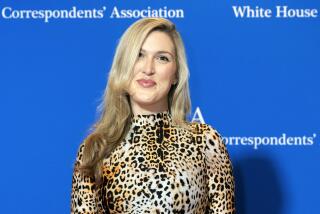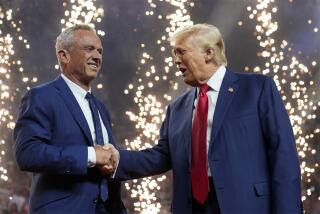George Takes a Bow : Magazines: John Kennedy Jr. launches his politics-through-culture magazine, while a competitor prepares to debut Sunday.
- Share via
NEW YORK — The week after Labor Day, Americans are traditionally blindsided by a new political season--speeches and sparring among aspirants for President or town clerk. This week two unusual candidates for political attention are emerging with typical hype and pandering. But this time the hopefuls are magazines, not men.
On Thursday the inaugural issue of George, a thick, glossy bimonthly about political personalities co-founded by John F. Kennedy Jr., was launched at a news conference that felt like a kickoff for a presidential run. Or, as one bystander suggested, the unveiling of the Sports Illustrated swimsuit issue.
The magazine, named for the first American President, was distributed to a media mob in Manhattan’s Federal Hall, in the rotunda where George Washington gave his inaugural address in 1789.
Editor-in-chief Kennedy, tanned and in a navy double-breasted suit, was flanked by his partner, Michael Berman, and the head of Hachette Filipacchi, which publishes 27 magazines including Elle and Boating and intends to spend $20 million to get George to turn a profit.
With an unprecedented 175 pages of advertising in a first issue, super-model Cindy Crawford on the cover, a burgeoning table of contents, 500,000 copies in distribution as of Sept. 26, and the son of a President on the podium gushing about his dream to draw the public into politics through upbeat and irreverent journalism, George had about the most potent start-up imaginable in a time when the price of paper is soaring and 1,600 new magazines come out annually.
The other novice on the advertising hustings is the Standard, a slimmer but no less ambitious Washington-based opinion magazine focusing on conservative politics that will have a low-key launch on Sunday. Copies will be hand-delivered to the homes of important people in the media and politics in New York and the nation’s capital, says Executive Editor Fred Barnes.
On Monday, another 125,000 copies will be distributed to subscribers picked up in a direct-mail campaign. Financed with $3 million from Rupert Murdoch’s media empire and modeled after the New Republic, the first issue of the Standard has 30 ad pages, although Barnes expects it will be difficult to sustain that level of interest among advertisers and readers.
“We want to be a magazine that is influential and spurs the political world, so we have to have that article every week that gets people talking,” says Barnes, a former White House correspondent for the New Republic, who co-founded the Standard with William Kristol and John Podhoretz both sons of well-known neoconservative thinkers.
In fact, although executed differently, both George and the Standard hope to seize upon an alleged heightened public interest in politics.
“The public is more engaged than ever before and the most serious debates are among conservative ideas,” Barnes said in a phone interview last week.
By contrast, George casts itself as nonpartisan and plans to stick to personalities rather than dry policy debates or critical journalism. But like Barnes, Kennedy said he also sees more people attuned to politics, and that he chose to run a magazine that looks at politics through culture--perhaps rather than run for office himself--because he believes Americans are eager to break away from politics as usual.
Kennedy and Berman, a public relations expert, originally wanted to start a more serious, smaller-scale magazine. After unsuccessfully shopping that idea in Manhattan publishing circles they were persuaded by Hachette Filipacchi, a subsidiary of a French defense contractor, to gloss up and go mass market.
The magazine group, which has elevated its profile through its association with the Kennedy once dubbed The Sexiest Man Alive, brought him along to pitch potential advertisers for George and its other magazines.
Edited by a staff of 20 mostly young editors who came from magazines such as Spin and Esquire, the first issue of George includes a few restrained profiles, a mild interview by Kennedy with George Wallace, an elegantly written essay by novelist Caleb Carr, an informative piece about the war against Time Warner over gangsta rap and a tedious chat between Cindy Crawford and Isaac Mizrahi about how awful people dress in D.C. The endpaper of the 280-page magazine is a flat attempt by Madonna at being provocative. If she were President, she writes, she would see to it that “the entire armed forces came out of the closet.”
Yet Kennedy insisted that he’ll try to keep away from the “seamy” side of politics at the same time that he recognized his magazine has to “maintain an edge.”
Summing up the challenge to tantalize but not titillate, he noted that his “Uncle Ted,” the senator from Massachusetts, told him that if they were still talking in a few months, the younger Kennedy wasn’t doing his job.
There was no missing the irony of a member of the Kennedy family, whose personal lives have been endlessly scrutinized in the media, now being in the business of scrutinizing.
In fact, Kennedy was coy if not clever in deflecting curiosity Thursday from his romance with Caroline Bessette, who works for Calvin Klein and who the New York Post recently reported--and Kennedy denied--is considering his offer of marriage.
Anticipating questions about his love life, Kennedy said with a small smile, “Yes, yes, no. . . . We’re really just friends. . . . She’s my cousin.”
That ended it.
Asked what his late mother, Jackie Onassis, would have thought that day, Kennedy said she would have been “mildly amused, glad she wasn’t standing up here and proud.”
Some skeptics believe Bessette has a lot better chance of nabbing her ladies’ man than his magazine has of making money.
“I don’t fault the concept but the number of people, 500,000, they think are going to be interested in it may be faulty,” said Anne Russell, editor of Folio, a magazine about the magazine industry. “You want to drop dead on the newsstand? Put a politician on it. These people seem to believe that politicians are the rock stars of the ‘90s. I don’t see it.”
John R. MacArthur, president and publisher of Harper’s magazine, said he thought George had been over-hyped, making it “difficult for the magazine to be judged in a legitimate way.
“If I were the guys at Hachette I would have let Kennedy be who he wanted to be--do a more serious magazine--and see if it grows,” MacArthur said. “If you start out more modestly the issues down the road don’t look like such a bomb.”
Both MacArthur and Russell speculated that the Standard might survive longer because, unlike Hachette, Murdoch’s desire to own a political voice in Washington may be greater than his need to make a profit.
But nobody is more realistic than John Kennedy about that critical moment when his celebrity stops buying attention for the magazine and George has to capture a loyal following of advertisers and readers.
“Ultimately this magazine is going to stand on its own and that will come a couple of issues down the line when my last name doesn’t matter,” Kennedy said.
More to Read
Get the L.A. Times Politics newsletter
Deeply reported insights into legislation, politics and policy from Sacramento, Washington and beyond. In your inbox twice per week.
You may occasionally receive promotional content from the Los Angeles Times.










